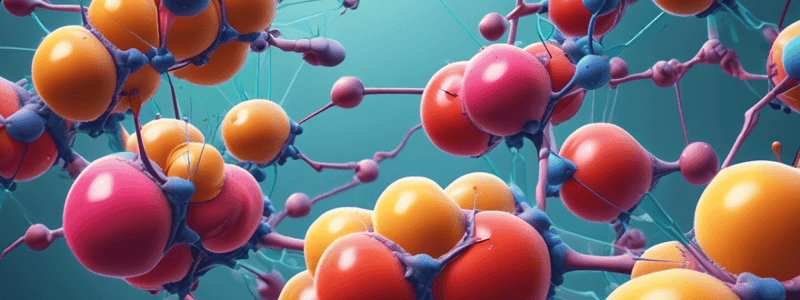Podcast
Questions and Answers
What is the main fuel source that almost all organisms use?
What is the main fuel source that almost all organisms use?
- Lipids
- Fats
- Proteins
- Glucose (correct)
How many transmembrane α-helices do glucose transporters possess?
How many transmembrane α-helices do glucose transporters possess?
- 8
- 6
- 12 (correct)
- 10
In glycolysis, what is the function of NADH?
In glycolysis, what is the function of NADH?
- Generate glucose molecules
- Produce enzyme catalyzed reactions
- Carry electrons to produce ATP (correct)
- Transport glucose into the cell
During which phase of glycolysis is glucose converted to glyceraldehyde 3-phosphate (GAP)?
During which phase of glycolysis is glucose converted to glyceraldehyde 3-phosphate (GAP)?
How many ATP molecules are invested in the conversion of glucose to glyceraldehyde 3-phosphate (GAP) in glycolysis?
How many ATP molecules are invested in the conversion of glucose to glyceraldehyde 3-phosphate (GAP) in glycolysis?
What is the end product generated from the conversion of two molecules of GAP during the Payoff Phase of glycolysis?
What is the end product generated from the conversion of two molecules of GAP during the Payoff Phase of glycolysis?
How many molecules of NADH are produced from the entire process of glycolysis?
How many molecules of NADH are produced from the entire process of glycolysis?
Which type of energy is carried by NADH in glycolysis?
Which type of energy is carried by NADH in glycolysis?
What is the function of Hexokinase in glycolysis?
What is the function of Hexokinase in glycolysis?
What is the role of Phosphoglucose Isomerase?
What is the role of Phosphoglucose Isomerase?
Why is Phosphofructokinase considered a committed step in glycolysis?
Why is Phosphofructokinase considered a committed step in glycolysis?
What does Aldolase do in glycolysis?
What does Aldolase do in glycolysis?
Why is Triose phosphate isomerase considered important in glycolysis?
Why is Triose phosphate isomerase considered important in glycolysis?
Which enzyme employs substrate-binding induced fit in glycolysis?
Which enzyme employs substrate-binding induced fit in glycolysis?
What is the fate of glyceraldehyde 3-phosphate in glycolysis?
What is the fate of glyceraldehyde 3-phosphate in glycolysis?
Why is the kcat /KM ratio close to the diffusion-controlled limit for Triose phosphate isomerase?
Why is the kcat /KM ratio close to the diffusion-controlled limit for Triose phosphate isomerase?
Which enzyme catalyzes the reaction that produces ATP through substrate-level phosphorylation in glycolysis?
Which enzyme catalyzes the reaction that produces ATP through substrate-level phosphorylation in glycolysis?
What is the main purpose of the final three reactions in glycolysis?
What is the main purpose of the final three reactions in glycolysis?
What compound is phosphorylated to make ATP through substrate-level phosphorylation?
What compound is phosphorylated to make ATP through substrate-level phosphorylation?
Which process involves the direct transfer of a phosphate to ADP from a phosphorylated intermediate compound?
Which process involves the direct transfer of a phosphate to ADP from a phosphorylated intermediate compound?
What is the net result of glucose catabolism through glycolysis?
What is the net result of glucose catabolism through glycolysis?
Which enzyme catalyzes a thermodynamically favorable reaction in glycolysis?
Which enzyme catalyzes a thermodynamically favorable reaction in glycolysis?
What decreases the activation energy barrier in the second half of the Glyceraldehyde 3-phosphate Dehydrogenase-catalyzed reaction?
What decreases the activation energy barrier in the second half of the Glyceraldehyde 3-phosphate Dehydrogenase-catalyzed reaction?
Which compound has a higher phosphoryl transfer potential than ATP?
Which compound has a higher phosphoryl transfer potential than ATP?
What happens during the formation of ATP by substrate-level phosphorylation in glycolysis?
What happens during the formation of ATP by substrate-level phosphorylation in glycolysis?
Flashcards are hidden until you start studying




